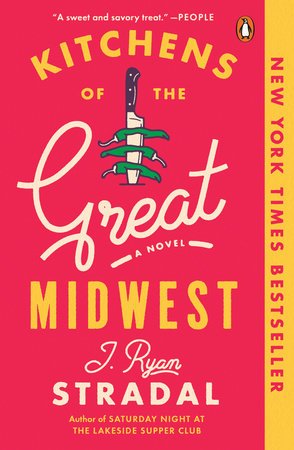READERS GUIDE
AN INTRODUCTION TO KITCHENS OF THE GREAT MIDWEST As soon as Eva Thorvald enters the world, her culinary destiny is all but sealed. Her doting chef-father, Lars, surrounds her with delicious smells, the lilting sounds of James Beard’s prose, and even an illicit taste of puréed braised pork shoulder before she’s technically supposed to eat it.
Young family life seems to be going fine until Cynthia, Lars’s wine-enthusiast wife, suddenly abandons them for a dashing sommelier, claiming she’s not cut out to be a mother. Shortly after, Eva’s life is once again touched by tragedy.
When Eva’s still an infant, she’s adopted by Lars’s brother, Jarl, and his wife, and grows up sensing that she’s not quite like the rest of her family, starting with their abysmal taste in food. By age ten, she’s cultivating her own hydroponic hot peppers in her closet, developing a craving for organic sorbet, and hanging out in restaurant kitchens. By high school, she finds a restaurant willing to take her on as an apprentice, and has her first experience with love as she captures the attention of Will Prager, the romantic, high school indie rocker who tries to woo her with gourmet meals.
After years developing her craft in various kitchens, Eva sets out to develop a pop-up supper club series set in exotic, dramatic venues. The legends surrounding her are surpassed only by her transcendent cooking, known to make grown men weep with joy. By now, with foodie culture in full swing, she’s a celebrated icon with a years-long wait list to get into The Dinner, an epic meal that evokes Eva’s entire life.
In J. Ryan Stradal’s witty, often hilarious debut, Eva’s story is told in chapters—one for each of the most influential ingredients in her life—and told by the people who make these fateful culinary introductions, intentionally or otherwise. Much like an unforgettable five-course meal, the resulting novel creates a sensory experience and unexpected emotional resonance.
Kitchens of the Great Midwest is at once profoundly moving, slyly hilarious, and wonderfully original—it’s a true feast for the heart that will have many readers coming back for seconds.
QUESTIONS AND TOPICS FOR DISCUSSION 1. From an early age, Eva is obsessed with food and cooking. What influences shape her interest?
2. How would you characterize the Midwest as Stradal paints it in this book? What makes the setting unique and important for this particular story?
3. Stradal structures the novel as a collection of smaller vignettes from many different points of view. What are the advantages of this narrative style?
4. Throughout the novel, characters and stories intersect in unexpected ways. Which of these connections surprised you most? Which seem most important to Eva’s story?
5. Food takes center stage in this book. How does it bring people together and how does it keep them apart?
6. At times, Stradal seems to poke fun at foodie culture. Which scenes or exchanges between characters struck you as a strong commentary on this foodie evolution?
7. Eva Thorvald is the heroine of the novel, but in some ways she is still quite mysterious. What is it about her that draws people to her?
8. From Lars to Eva to Pat, Stradal’s characters have their own prejudices about food and the way it should be made. What are some of their ideas, and which ones do you agree or disagree with?
9. Cindy has always claimed she would never be a good mother. Why does she insist on this and do you believe her?
10. The recipes prepared in Eva’s feast serve as a walk through her memory. How do foods or recipes play a role in your own memory or life story?

